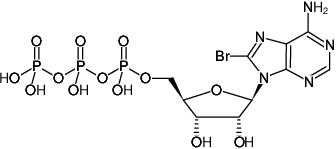(8Br-ATP)
8-Bromo-adenosine-5'-triphosphate, Sodium salt
| Cat. No. | Amount | Price (EUR) | Buy / Note |
|---|---|---|---|
| NU-997-20 | 20 mg | 124,60 | Add to Basket/Quote Add to Notepad |
| NU-997-100 | 100 mg | 537,30 | Add to Basket/Quote Add to Notepad |

For general laboratory use.
Shipping: shipped on gel packs
Storage Conditions: store at -20 °C
Short term exposure (up to 1 week cumulative) to ambient temperature possible.
Shelf Life: 12 months after date of delivery
Molecular Formula: C10H15N5O13P3Br (free acid)
Molecular Weight: 586.08 g/mol (free acid)
Exact Mass: 584.91 g/mol (free acid)
CAS#: 81035-56-5
Purity: ≥ 95 % (HPLC)
Form: solid
Color: white to off-white
Spectroscopic Properties: λmax 264 nm, ε 17.0 L mmol-1 cm-1 (Tris-HCl pH 7.5)
Applications:
Agonistic ligand, mainly for nucleoside receptor A1, with less affinity to A3
Nucleoside-triphosphates can be converted by different membrane-bound phosphatases into nucleosides acting as nucleoside receptor ligands. In some cases nucleoside phosphates act also directly on nucleoside receptors.
Specific Ligands:
Ligand for purinergic receptors:
P2Y2[1]
P2X purinoreceptor[2]
BIOZ Product Citations:
Selected References:
[1] Lazarowski et al. (1995) Pharmacological selectivity of cloned human P2U-purinoreceptor: potent activation by diadenosine tetraphosphate. Br. J. Pharmacol. 116 (1):1619.
[2] Bo et al. (1994) Comparative studies on affinities of ATP derivatives for P2X-purinoreceptors in rat urinary bladder. Br. J. Pharmacol. 112 (4):1151.
Volonte et al. (2009) Membrane components and purinergic signalling: the purinome, a complex interplay among ligands, degrading enzymes, receptors and transporters. FEBS J. 276:318.
Yegutkin (2008) Nucleotide and nucleoside converting enzymes: Important modulators of purinergic signalling cascade. Biochim. Biophys. Acta 1783:673.
Carrasco et al. (1998) Interaction of adenosine nucleotide analogs with Saccharomyces cerevisiae phosphoenolpyruvate carboxykinase. BBA-Protein Struct. M. 1429 (1):93.
Maruta et al. (1998) Characterization of the interaction of myosin with ATP analogues having the syn conformation with respect to the adenine-ribose bond. Eur. J. Biochem. 256 (1):229.
Beukers et al. (1993) Characterization of ecto-ATPase on human blood-cells - a physiological-role in platelet-aggregation. Biochem.Pharmacol. 46 (11):1959.
Juodka et al. (1993) Substrate-specificity of T4 RNA-ligase - role of the purine base of the nucleotide in formation of the covalent AMPRNA-ligase complex. Biochemistry-Moscow 58 (6):576.
Homas et al. (1991) A receptor that is highly specific for extracellular ATP in developing chick skeletal-muscle invitro. Brit. J. Pharmacol. 103 (4):1963.
Champeil et al. (1988) ATP regulation of sarcoplasmic-reticulum Ca-2+-ATPase - metal-free ATP and 8-bromo-ATP bind with high-affinity to the catalytic site of phosphorylated ATPase and accelerate dephosphorylation. J. Biol. Chem. 263 (25):12288.
Szilagyi et al. (1988) Effect of 8-Br-ATP as a bound nucleotide on the molecular-dynamics of actin. J. Muscle Res. Cell M. 9 (1):93.
Kuryavyi et al. (1987) Influence of 8-Br-ATP and 8-Oxy-ATP on rna-synthesis by escherichia-coli rna-polymerase. Biochemistry-Moscow 52 (1):127.
Kuryavy et al. (1984) Effect of 8-Bromo-ATP on RNA-synthesis by Escherichia-coli RNA-polymerase invitro. Stud. Biophys. 101:165.
Bruskov et al. (1982) Recognition of 8-Bromo-ATP in the RNA-polymerase reaction. Stud. Biophys. 87 (2):173.
Nagel et al. (1976) Chromatographic investigation of substrate properties of 8-Bromo-ATP in nucleoside diphosphate kinase reaction. J. Clin. Chem. Clin. Bio. 14 (9):429.